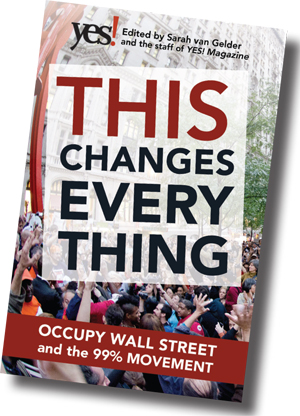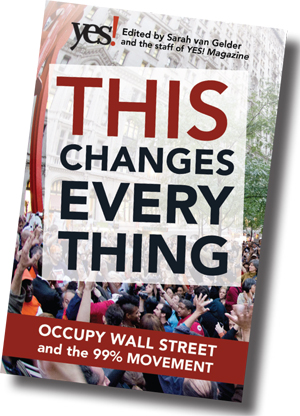 Police have razed and arrested their way through Zuccotti Park, but the Occupy movement isn’t going away. This week, there’s a new, tangible manifestation of the movement’s staying power: the first Occupy Wall Street book. This Changes Everything: Occupy Wall Street and the 99% Movement will hit bookstores on Nov. 17, but it’s already available for purchase in print or via download.
Police have razed and arrested their way through Zuccotti Park, but the Occupy movement isn’t going away. This week, there’s a new, tangible manifestation of the movement’s staying power: the first Occupy Wall Street book. This Changes Everything: Occupy Wall Street and the 99% Movement will hit bookstores on Nov. 17, but it’s already available for purchase in print or via download.
Compiled and edited by the staff of YES! magazine, it features contributions from established authors — Naomi Klein, Ralph Nader, David Korten, Rebecca Solnit — as well as unsung activists. When Berrett-Koehler Publishers approached the magazine six weeks ago about the possibility of doing an “instant book,” the YES!ers, of course, said “Yes!” It only made perfect sense, as YES! has been covering people’s movements and the fight against corporate power for 15 years.
The first 10,000 copies are now being shipped out; 500 of them will be distributed free at Occupy sites. And royalties from all sales of the book will go to the Occupy movement.
Get a taste of the book from this adapted excerpt, written by Sarah van Gelder and David Korten, cofounders of YES! magazine, and Steve Piersanti, publisher of Berrett-Koehler:
Ten Ways the Occupy Movement Changes Everything
Before the Occupy Wall Street movement, there was little discussion of the outsized power of Wall Street and the diminishing fortunes of the middle class. The media blackout was especially remarkable given that issues like jobs and corporate influence on elections topped the list of concerns for most Americans.
Occupy Wall Street changed that. In fact, it may represent the best hope in years that “we the people” will step up to take on the critical challenges of our time. Here’s how the Occupy movement is already changing everything:
1. It names the source of the crisis.
Political insiders have avoided this simple reality: The problems of the 99% are caused in large part by Wall Street greed, perverse financial incentives, and a corporate takeover of the political system. Now that this is understood, the genie is out of the bottle and it can’t be put back in.2. It provides a clear vision of the world we want.
We can create a world that works for everyone, not just the wealthiest 1%. And we, the 99%, are using the spaces opened up by the Occupy movement to conduct a dialogue about the world we want.3. It sets a new standard for public debate.
Those advocating policies and proposals must now demonstrate that their ideas will benefit the 99%. Serving only the 1% will not suffice, nor will claims that the subsidies and policies that benefit the 1% will eventually “trickle down.”4. It presents a new narrative.
The solution is not to starve government or impose harsh austerity measures that further harm middle-class and poor people already reeling from a bad economy. Instead, the solution is to free society and government from corporate dominance. A functioning democracy is our best shot at addressing critical social, environmental, and economic crises.5. It creates a big tent.
We, the 99%, are people of all ages, races, occupations, and political beliefs. We will resist being divided or marginalized. We are learning to work together with respect.6. It offers everyone a chance to create change.
No one is in charge; no organization or political party calls the shots. Anyone can get involved, offer proposals, support the occupations, and build the movement. Because leadership is everywhere and new supporters keep turning up, there is a flowering of creativity and a resilience that makes the movement nearly impossible to shut down.7. It is a movement, not a list of demands.
The call for deep change — not temporary fixes and single-issue reforms — is the movement’s sustaining power. The movement is sometimes criticized for failing to issue a list of demands, but doing so could keep it tied to status quo power relationships and policy options. The occupiers and their supporters will not be boxed in.8. It combines the local and the global.
People in cities and towns around the world are setting their own local agendas, tactics, and aims. What they share in common is a critique of corporate power and an identification with the 99%, creating an extraordinary wave of global solidarity.9. It offers an ethic and practice of deep democracy and community.
Slow, patient decision-making in which every voice is heard translates into wisdom, common commitment, and power. Occupy sites are set up as communities in which anyone can discuss grievances, hopes, and dreams, and where all can experiment with living in a space built around mutual support.10. We have reclaimed our power.
Instead of looking to politicians and leaders to bring about change, we can see now that the power rests with us. Instead of being victims to the forces upending our lives, we are claiming our sovereign right to remake the world.Like all human endeavors, Occupy Wall Street and its thousands of variations and spin-offs will be imperfect. There have already been setbacks and divisions, hardships and injury. But as our world faces extraordinary challenge — from climate change to soaring inequality — our best hope is the ordinary people, gathered in imperfect democracies, who are finding ways to fix a broken world.



